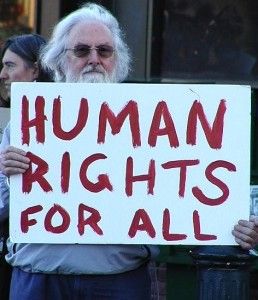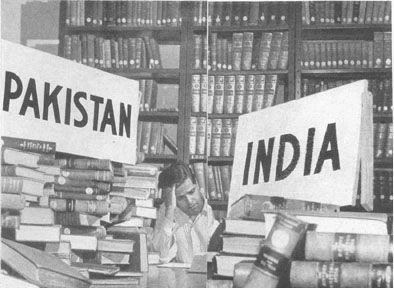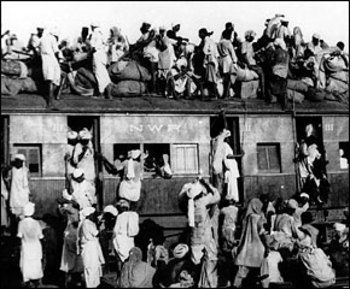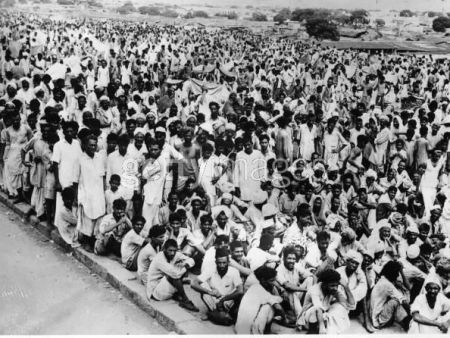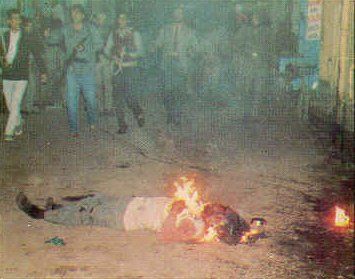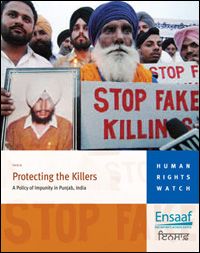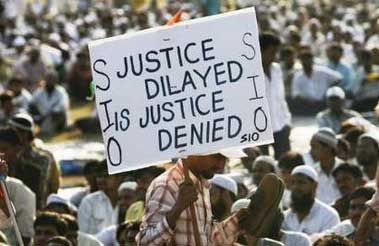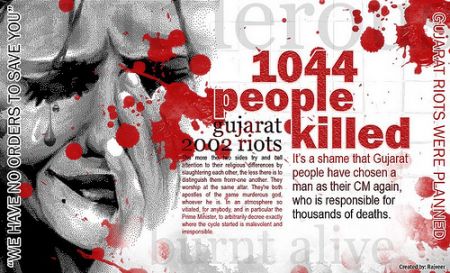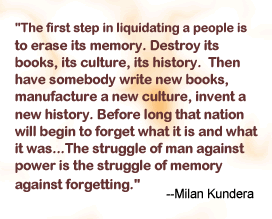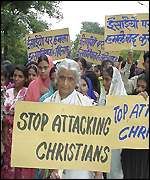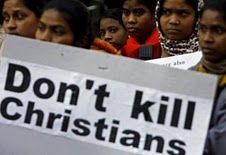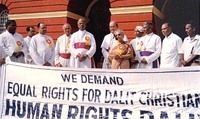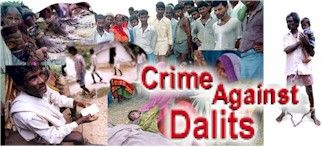STORY about ArtsCooperativesDirect ActionEducationIdeasPeace/WarPovertySolidarity posted on August 15, 2011 by Satnam Singh Sangra
Indian Independence and the Plight of Minorities in India
Persecution of Minorities Continues as India Celebrates its 64th Independence Day
Also posted by Satnam Singh Sangra:
Also in Solidarity:
On August 15th, India will be celebrating its Independence Day, and rightly so. After decades of resistance the Indian people succeeded in ridding India of an exploitative and oppressive British colonial government. Indeed this was a tremendous achievement in the annals of Indian history. This independence, however, was not achieved easily. When everything was said and done, the mighty subcontinent was divided into a Hindu majority India and Muslim majority Pakistan. The partition of these two countries resulted in the largest mass migration in world history with roughly about 10 million people being displaced and another one million dead. The gravest losses were faced by the Sikhs and Muslims who’s homeland Punjab was divided in two halves.
Despite the violence, displacement and death that partition brought forth, there was a general mood of celebration and cheerfulness among the majority Indian populace. Indians were now masters of their own destiny, they did not need to worry about the oppression and exploitation that accompanied colonization. They were no longer considered second class citizens in their native land.
This week marks the 64th anniversary of Indian Independence. Millions of Indians will be celebrating Indian Independence Day with pomp and glamor across the globe. However, as a civilized society we cannot afford to lose ourselves amongst the colorful celebrations of Indian independence and the rhetoric filled speeches by political leaders praising India as the largest democracy on earth. We need to ask a difficult question about the plight of minorities in the Indian state: Did independence bring freedom for India’s religious minorities as well or was it simply a transition from one oppressor to the next?
After attaining independence one of the major achievements of the Indian state was the creation of its constitution. If some of the content of Independent India’s constitution was a hint of the future of minorities on the subcontinent, the future seemed bleak. The first minority group independent and free India chose to demoralize and victimize was the Sikhs. The new constitution attacked the very heart and soul of the Sikhs. Contrary to the core beliefs of Sikhs and despite their loud protests the very existence as Sikhism as an independent faith in India was denied by Indian law makers. Sikhism was relegated a mere sub sect of Hinduism. This claim is preposterous because Sikh ideology denounces the caste system, Brahmanism and idol worship; the very foundations of Hinduism. In addition Sikhism is a monotheistic faith whereas Hinduism is polytheistic.
The representatives of the Sikh community did not sign the Indian constitution protesting the blatant disregard of the Indian state for the sentiments of the Sikh minority. Despite decades of continued protests against this grave injustice, Sikhs are still labeled Hindus in the Indian constitution. To further demoralize them and remind them of their subjugation, the Sikhs in the Indian state are forced to get married under the Hindu marriage act. If this act of denying millions of citizens their fundamental right to legally exist as a distinct faith was foreshadowing of the treatment of minorities in the future, the message was clear. In independent India, the will of the majority would be imposed on the minority.
Despite facing numerous discriminatory policies of the Indian state, the prosperous Sikhs of Punjab made India self-sufficient in food production and sacrificed their lives in the tens of thousands protecting India’s borders in the Indo-China and Indo-Pakistan wars. In defiance of all logic, the patriotic fervor of the Sikhs was met with further isolationist and discriminatory policies of the Indian state. The brave and hardworking Sikhs were forced to launch a movement for their right to survive as a distinct religious minority and to live with dignity in India; the very country for which they spearheaded and supported the independence movement. The Sikh civil rights movement climaxed in the early 1980’s and took the shape of a mass movement of the Sikhs of Punjab.
Rather than addressing the grievances of the Sikhs in a civilized manner, the Indian state opted for a brutal response. In 1984 the Indian state unleashed a reign of terror in the northern Indian state of Punjab - the homeland of the Sikhs - to suppress their political aspirations. The holiest shrine of the Sikhs was attacked by Indian tanks, helicopters, commandos’ and chemical weapons. Thousands of books, manuscripts, hand written messages of the Sikh Gurus, and other priceless artifacts of the Sikh nation were stolen by the Indian army. Despite a statement by the then Indian Defense Minister George Fernandez in May, 2000 admitting that the relics and manuscripts of the Sikhs reference library were in the possession of the Indian government, they have never been returned. If you want to destroy a nation, steal their history, destroy their books, and attack their religion.
In November 1984, tens of thousands of Sikhs were massacred on the streets while Indian security forces stood idle or actively aided and abetted the murderous mobs. Post 1984 Punjab was made a virtual killing ground in which tens of thousands of Sikhs youths were targeted and murdered in what renowned human rights organizations have called extra judicial killings and what the Indian Supreme Court has termed “worse than genocide.”
Unfortunately, despite an overwhelming amount of evidence against the accused not a single person has been held responsible for the mass murders of Sikhs in the Punjab in the 1980’s and 1990’s and during the so-called anti-Sikh riots of November 1984. Every effort of the Sikhs to bring the perpetrators of crimes against humanity to justice has been scuttled by bureaucratic red tape of the Indian state. More recently, a Sikh political activist Devinder Pal Sing Bhullar has been given the death penalty despite that fact that he had been exonerated by a senior judge of the supreme court of India and in spite of the presence of evidence of a forced confession under torture while in custody of Indian security forces. In independent India the Sikhs continue to face a denial of justice.
The studied silence of civilized democracies on these grave human rights violations has only acted to further embolden the Indian state to carry out its program of brutal oppression of religious minorities. In 1992, fanatic Hindu fundamentalists with the blessing of many in government attacked and destroyed a Mosque in the northern Indian state of Uttar Pradesh in brazen daylight. The movement was lead by none other than L.K. Advani who went on to become the deputy home minister of India in 2002.
In 2002, the state of Gujrat in India witnessed mass targeted killings and sexualized violence of genocidal proportions of Muslims. According to international human rights organizations the murderous acts took place under the watchful eye of the state government. Despite eye witness testimony implicating the highest elected political officials including the Chief Minister – Narendra Modi – justice continues to evade the victims. The perpetrators of the genocide of Muslims in Gujrat were obviously emboldened by the impunity which the murderers of Sikhs in 1984 continue to enjoy to date. Unfortunately history sometimes repeats itself. In 1984 it was the genocide of the Sikhs. The perpetrators walked scotch free. In 2002, it was the genocide of the Muslims. The perpetrators walked scotch free. Is this a mere coincidence or are we beginning to see a very horrific pattern of how minorities are treated by the Indian state? In fact Narendra Modhi, the Chief Minister of Gujrat and mastermind of the Muslim massacre has recently destroyed all the documents related to the 2002 genocide of the Muslims. Justice has not only been delayed and denied, in the Indian state it has now been systematically eliminated for religious minorities like Muslims and Sikhs.
The targeted Killings of Sikhs and Muslims and the denial of justice to the victims by the Indian state are not a mere coincidence. The tales of brutal suppression of minorities in the Indian state are endless. Like the Sikhs and Muslims, the Christian minority in India continues to face daily harassment and threats of death for practicing their faith. Christianity is seen as a threat to Hindu fundamentalists who enjoy the backing of fundamentalist Hindu political parties like the BJP. In 2000, an Australian Christian missionary Graham Staines was burned alive along with his two young sons by Hindu fundamentalists. Unfortunately this is not an isolated incident. Many Christian priests have been killed or severely injured in hate motivated attacks and nuns have been raped all in a bid to put a stop to their missionary activities of serving humanity. In 2008 Hindu fundamentalists unleashed a reign of terror on the minority Christian population in the Indian state of Orissa. Hindu fundamentalists entered several churches during Sunday services, attacked the Christian congregations and burned down countless churches. Hundreds of Christians were killed and tens of thousands were force to flee their homes. In many cases when Christian went to file reports with their local police stations, the presiding officers refused to record them. Unfortunately, for many victims of the 2008 Christian massacre justice seems to be elusive in the Indian state.
In addition to this, Christian groups continue to report the torture of their members especially their leaders in a bid to silence them and to put an end to their missionary activities benefiting many downtrodden people of Indian society. Christians continue to be harassed and tortured in an attempt to have them renounce their faith; churches continue to me made targets of fundamentalist attackers; bibles have been reportedly confiscated and Christians have also reported beatings and harassment by government officials.
This is just the tip of the iceberg. Many other groups face discrimination and inequitable treatment in the Indian state as well. According to Human Rights Watch, 2007, about 170 million Dalits (considered untouchables according to the Hindu caste system) are condemned to a lifetime of abuse and degradation in India just because of their cast classification. The Adivasis also known as India’s first peoples are also relagated to a similar fate. They are considered to be less than human and are shunned from society. They are condemned to a lifetime of abuse and exploitation at the hands of the so-called higher castes. The Dalits and Adivasis continue to face widespread discrimination including: decreased educational opportunity; religious discrimination; economic disenfranchisement and targeted violence against women which is greatly under-reported. Despite constitutional guarantees, India’s so-called low castes are often denied access to public education.
This August 15th, we need to critically think about what independence means. We need to ask ourselves if Indian dependence actually brought freedom for all people on the Indian subcontinent. If the answer to this is no then it is high time for us to raise our voice against the oppression of minorities in India. August 15th, will truly be an independence day when religious minorities also get to experience a glow of freedom without the threat of murder and genocide in India – the so-called largest democracy in the world.
The site for the Vancouver local of The Media Co-op has been archived and will no longer be updated. Please visit the main Media Co-op website to learn more about the organization.
